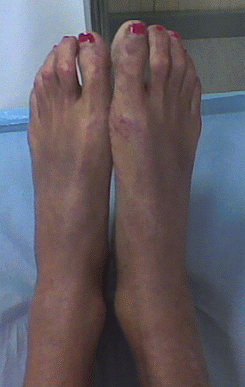ICEECE2012 Poster Presentations Clinical case reports - Thyroid/Others (81 abstracts)
Laminopathy and auto-immune sclerodermia: chance or necessity?
E. Parent 1 , A. Balavoine 1 , B. Lamblin 1 , H. Ytier 2 , C. Vigouroux 3 & M. Vantyghem 1
1Lille University Hospital, Lille, France; 2Roubaix General Hospital, Roubaix, France; 3Faculté de médecine Pierre et Marie Curie Site Saint-Antoine, Paris, France.
Some laminopathies associate both progeria and sclerodermic components (Am J Med Genet A 2006 Hennekam, J Cell Sci 2008 Sagelius), but most sclerodermic syndromes are not associated to LMNA mutations despite the presence of nuclear envelope antibodies, mainly directed to lamin (PNAS 1983 McKeon, Eur Respir J 2011 Dib).
A 15-th year old girl was referred for severely imbalanced diabetes and a voracious appetite interpreted as binge eating disorders. This girl had been diagnosed at 8 years old with auto-immune sclerodermic and insulin resistance syndromes. Hypertension, polycystic ovaries and insulin requiring hypertriglyceridemic diabetes occurred at 13 years old. Clinical features associated: weight 43 kg, height 160 cm, normal blood pressure with treatment, mandibular hypoplasia, face-sparing generalized lipoatrophy, muscular–skeleton disorders, distal sclerodermia with tendinous retractions and telangiectasies confirmed by capillaroscopy. Fasting blood glucose and C-peptide levels were respectively 2.5 g/l (n<1) and 13 ng/ml (n<2). HbA1c was 9.2% (n<6), ALAT 126, ASAT 307 (n<40 UI/l), leptin 2 ng/ml (n 3.5–11), total fat mass 11% (n:30–40 DEXA), intra/ total abdominal fat mass 52/84cc with severe liver steatosis 26% (MRI) and fibrosis F2 (biopsy). Cardiac investigations showed mild anomalies. Anti-nuclear autoantibodies have been found constantly positive since the age of 8 (1/640ème)), without other auto-antibodies. A de novo D47Y LMNA mutation was found.
This sclerodermic syndrome associated to this laminopathy could be linked i) to the severity of the glucose imbalance, generating a disorder of glycosylation ii) to the N-terminal type of LMNA mutation, rather encountered in progeria with sclerodermic disorders iii) to the cell or nucleus stress induced by the laminopathy leading to a release of nuclear envelope antigens, generating a non-specific occurrence of anti-nuclear auto-antibodies. Altogether, this case report offers new insights on the mechanisms linking inherited and auto-immune forms of lipodystrophies and sclerodermia, in line with those reported in PSMB8 mutations.
Sclerodermia with telangiectasies.
Declaration of interest: The authors declare that there is no conflict of interest that could be perceived as prejudicing the impartiality of the research project.

Funding: This research did not receive any specific grant from any funding agency in the public, commercial or not-for-profit sector.




